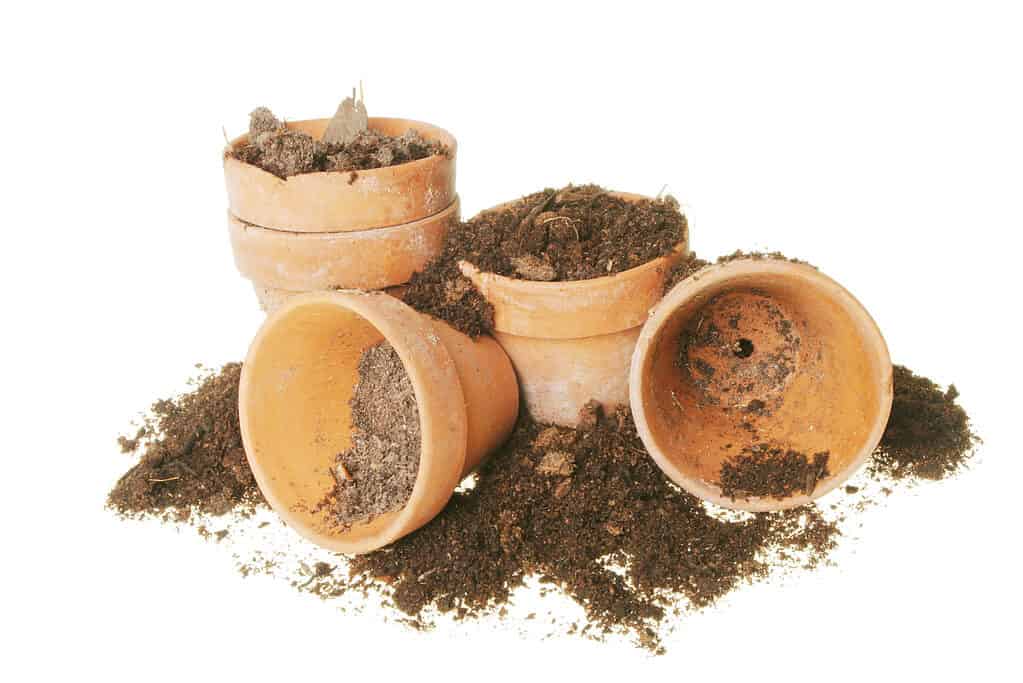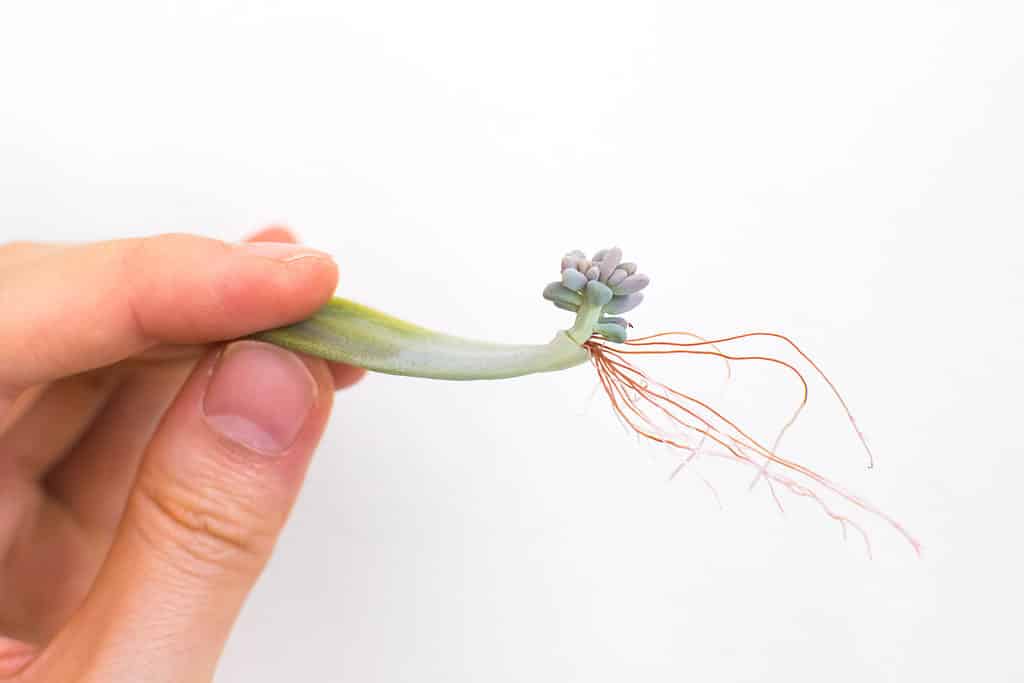Caring for succulents indoors can be very rewarding. With their unique shapes, sizes, colors, and textures, there is a dizzying variety of succulents to choose from! They are also easy to care for and require minimal effort since they prefer dry soil and little water. Additionally, the more you have, the more they will multiply. Your collection can grow quickly, which makes them an ideal affordable choice for those with limited budgets.
Providing the perfect care for succulents indoors can be tricky, but with the right knowledge and a few helpful tips, you’ll never have to worry about them dying again. There are a lot of myths out there when it comes to taking care of succulents that can lead inexperienced gardeners astray. To make sure your potted plants thrive and bring joy for years to come, follow our guide on how to properly care for your indoor succulent!

With the proper care your indoor collection of succulents can thrive.
©GRACIELLADEMONNE/Shutterstock.com
Pot
Terracotta or Ceramic – Terracotta and ceramic are both great options for succulent pots, as they provide plenty of air circulation to the roots while also allowing excess water to drain away. However, these materials can be quite heavy when filled with soil and plants, so make sure you have a secure spot in which to place them where they won’t get accidentally knocked or dropped. And don’t forget that terracotta is porous, which means it will absorb some of the moisture from your plant’s soil. This makes unglazed terracotta an especially good choice. You’ll be able to see the water line on the outside of the pot and know exactly when your succulents need watering!

Terracotta pots are a great option for planting succulents, providing air circulation to the roots while also allowing excess water to drain away.
©iStock.com/Griffin24
Plastic — Plastic is a great option for succulent pots and planters, as it’s not as fragile as ceramic. It can also be lighter in weight and comes in an array of bright colors and interesting shapes. However, plastic is not as breathable as terra cotta or ceramic, making it harder for water to evaporate from the soil. To avoid this issue, make sure you use well-draining soil with your plastic pot and that there is a drainage hole in the bottom of the pot so excess water can easily escape. With proper care, a plastic pot or planter can be just as effective at growing healthy succulents indoors!
Metal or Glass — Non-porous materials such as metal and glass are not ideal for succulents because they do not allow air circulation. This can lead to an accumulation of moisture within the soil which in turn causes root rot, fungus, and other issues that will cause damage to your succulent.
Wood — When selecting a wood pot for your succulent, it’s important to choose one that has adequate drainage holes at the bottom. This will ensure that excess water can properly drain away from the roots of your plant and prevent root rot, which is fatal for most succulents. Consider using an unfinished or lightly stained pot so you can easily monitor moisture levels in the soil by observing any dark patches on the outside of the pot.
Pot Size — No discussion of plant pots would be complete without mentioning the size of the container. Many new gardeners make the mistake of choosing a pot that is way too large for their tiny new succulent. All of that extra soil around the plant retains moisture (bad for plants that love the desert) and is a landing and breeding site for fungus gnats and other insects. A good general recommendation is to leave only half an inch between the plant and the edges of the pot.
Soil
When choosing the correct soil for your succulent, do your best to channel your inner cactus. Think grainy and free-draining thoughts. There are many commercial potting mixes available that say cactus/succulent on the bag. These all work just fine.
You are also welcome to make your own mixture by combining two parts potting soil, two parts sand, and one part perlite or pumice. The ratios can be slightly different for some types of succulents, but for most drought-tolerant sun-loving succulents, this mixture will be a-okay.
Light
Sunlight – A general rule of thumb for most succulents is a minimum of six hours of bright sunlight per day. Plants also need a period of darkness to rest each day. Succulents that require direct light do well in a south-facing window. Succulents that need indirect light do well in an east or west-facing window. In the northern hemisphere, north-facing windowsills do not provide enough light for most succulents.
Grow Light – Artificial lights designed for plants can be a great addition to an indoor garden. Lights imitate the rays of the sun, allowing you to grow a succulent in an otherwise dark area of your home. For succulents, be sure the light is 2,000 lumen per square foot and contains a full spectrum of light. The optimal light spectrum for succulents is 5,000 kelvins. Choose an LED light for energy savings and put it on an automatic timer. If the plant is in a low-light area of the house, give it 16-18 hours of artificial light per day.

A general rule of thumb for most succulents is a minimum of six hours of bright sunlight per day.
©iStock.com/diliananikolova
Water
Every plant has unique watering requirements. The best thing you can do is check the plant to see if it needs watering instead of watering it at specific calendar intervals. To check for dryness, try lifting the pot to see if it is lightweight. You can also use your finger to test the soil for dryness. Some people use moisture meters to test the soil before watering. Many succulents will communicate when they need water by showing wrinkly or shriveled leaves. When the leaves look less bright or less plump, your plant is asking for water.
Food
Fertilizer is another variable to consider when growing succulents indoors. In general, most succulents are not heavy feeders. A diluted mixture of fish emulsion or other liquid fertilizer once per month during the growing season is plenty of food for most succulents. It is not recommended to use slow-release or full-strength fertilizer on succulents as their roots burn easily.
Propagation
One of the best parts of succulents is their ease of propagation. They provide loads of free plants! If a leaf or stem snaps off of your plant, do not fear, this is a baby plant in the making. Simply place the cutting on a bright windowsill for two or three days to dry out. The cut end will dry and form a callus. When this happens, it is time to lay it on the soil. Prepare a small container with appropriate cactus soil and lay the cutting on top of the soil horizontally. Do not bury any part of the cutting. Before you know it, roots will form, and you can properly plant your new baby succulent.

If a leaf or stem snaps off of your succulent you can use it to grow a new plant once it starts to produce roots.
©iStock.com/frwooar
Pests and Disease Prevention
Bacterial and Fungal – Cacti and succulents grown indoors are often plagued by overwatering. Too much moisture causes infections. The best cure for these is to let the plant dry out properly. The best prevention is adequate airflow, plenty of sunlight, lots of time to dry between waterings, and a pot made of porous material.
Insects – Succulents are susceptible to mealybugs, scale, spider mites, and fungus gnats. The best prevention is a strong, healthy plant. Provide your plant with an ideal growing environment, and it is likely to remain pest free. Frequent plant inspections can really help as well. Take a strong flashlight and do a thorough inspection. Check the soil for pests, and check in between each leaf, including the underside of the leaves. It is much easier to fight a pest at the first sign of an issue rather than after a full infestation.
The photo featured at the top of this post is © jenn1ferl0uise/Shutterstock.com
Thank you for reading! Have some feedback for us? Contact the AZ Animals editorial team.







